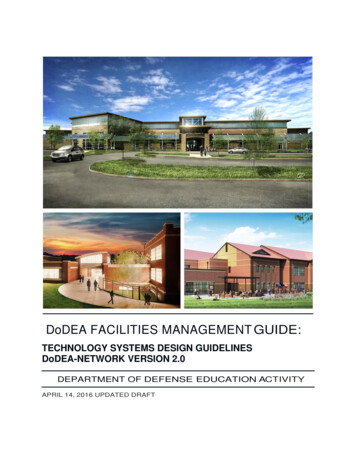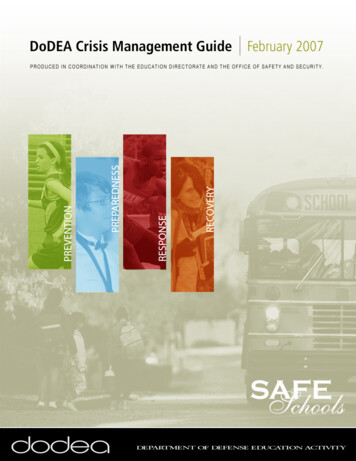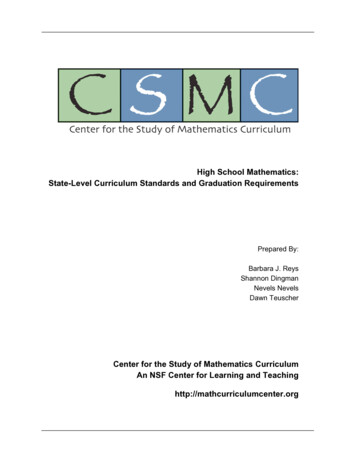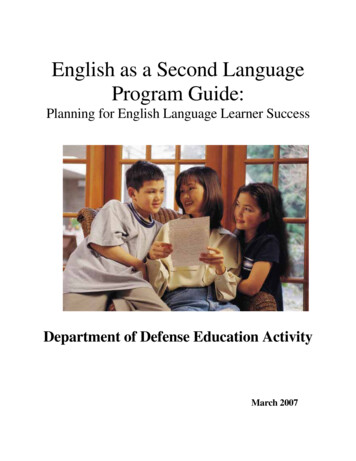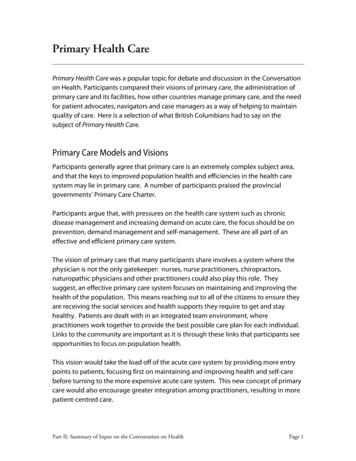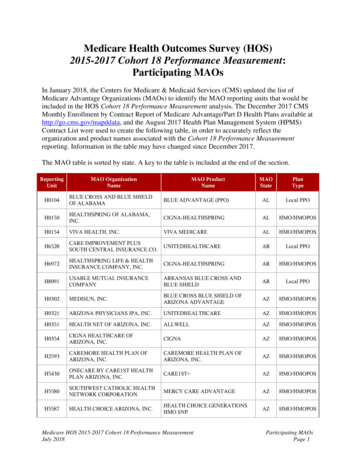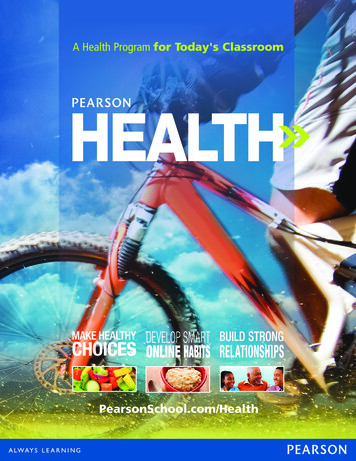
Transcription
PearsonSchool.com/Health
HSH14 SE U01 C03.qxdBuilding Health SkillsPearson Health helps students develop the skills they need as theywork to improve their personal and interpersonal health. Eachhealth skill, appearing once in every chapter, is taught and thenreinforced, ensuring that students master these essential life skills.Practice the Skillset the scene for learning new health skills.gives students an opportunity to practice andapply their newly learned skill.5/4/132:16 PMPage 68HSH14 SE U01 C03.qxd5/4/132:16 PM2:16 PMPage 64Lowered Resistance to Disease The immune system protectsyour body from disease through a complex process involving many speThe student-friendly cializedwritingstyle and engaging activities makecells.67When you speak of fighting off the flu or a cold, yourHSH14 SE U01 C03.qxd 5/10/13 10:15 AM Pagelearning about healthimmunefun, systemrelevant,meaningful.does theandfighting.When your immune system functionswell, you are better able to resist some of the illnesses to which you haveHands-On Activities been exposed.Scientific research has shown that, during the alarm stage, someThese activities engage studentspartsin activeof your immune system may function better than usual.explorationsResiliencethat reinforce importantDrinks,SoftHowever, prolonged Sportsstress canpreventthe Drinks,immune system from funcSome people seem to tolerate high levels of andstress.YourTheyTeethhealth concepts.tioning well. If your immune system is weakened, you may developIn thisactivity,tend to view stressful events as challenges ratherthanas you will observe how various drinksaffectare composedsome ofpeople with diseasesminor illnesses, suchaseggshells,colds,whichmoreoften.of Forthreats. For example, they might view the loss ofa jobmaterials as your teeth.the samesuch as cancer, a weakenedimmune system makes it harder to conas an opportunity to pursue a new career. Also,MaterialstheyTry This1 Label the first cup “sports drink,” the second cup “soft drink,” andthe disease.they threebelieve that they are in trolcontrol—thatcanplastic cupsHSH14 SE U04 C14.qxdReal-World SituationsHSH14 SE U01 C03.qxd5/4/13Page 695/6/138:42 AMtape for labelingPracticing Healthful Behaviors3Last night, José stayed up late to write a reportthat was assigned two weeks ago. He plannedto do his math homework in the morning, butthen slept through his alarm. In his haste thismorning, José left his gym clothes at home.Running toward the school as the bell rang,José felt anxious and tense.José needs to manage his time better. Agood time manager completes daily tasks andstill finds time to relax. Follow these steps tobetter manage your time.1Track how you spendyour time.Use a sheet from a daily planner thatis divided into 15-minute blocks ormake your own version on ruledpaper. Prepare a sheet for each day ofthe week.Prioritize your tasks.Rate each task according to this scale.A very importantB somewhat importantC not very importantDo math homeworkDo laundryOutline history paperOrganize CDsCall grandmotherWatch TVPractice jump shotsGet permission slip signedUse the grids to track how youcurrently spend your “free” time.4Monday9:0010:0011:0012:001:002:00Algebra IEnglishAmerican HistoryEarth ScienceLunchStudio Art IBasketball PracticeMake a daily “To Do” list.Before you go to bed, make a list ofthe tasks you need to do the next day.5Include tasks that you know you haveto do, such as homework and chores,along with tasks that you would liketo do.Break long-range tasks, such as termpapers and projects, into smaller,more manageable tasks. This makesit easier to fit these tasks into yourschedule.ABACBCBAPlan your day.Assign an amount of time for each task.Make a practice of allowing more time for atask than you think it will require.Use copies of the grids you made in Step 1to schedule your tasks.Do not schedule too many tasks each day.Allow some time for unplanned events.2Try to do “A” tasks before you do “B” tasks,and “B” tasks before you do “C” tasks, evenif a “C” task is easier.Monitor your progress.At different points during the day, askyourself, “Is this the best use of my time?” Ifyour answer is no, consider these questions:Am I doing a “C” task because an “A” taskseems overwhelming? If so, break the “A” taskinto smaller steps that can be done in lessthan fifteen minutes.68make it easier for students to master essential health skills in thefollowing areas:2Analyzing InfluencesAccessingInformationIs this the right time to do this task? Forexample, if your math homework is challenging, don’t leave it until late at nightwhen you are tired.Am I being distracted by phone calls or instantmessages? Tell your friends when it is okay tocontact you and when you need time to concentrate on homework or chores. CommunicatingMaking DecisionsSetting Goals Practicing HealthfulBehaviorsAdvocacy5/4/138:30 AMPage 143Do the females tend to beless assertive than the males?People learn about gender roles by observing howother people behave. Family members, friends, andother adults may serve as roles models. People alsoreceive messages about gender roles from movies.Use this checklist to evaluate how gender roles areshown in a movie.Are the male roles moreaction-oriented than thefemale roles?Do the females share theirfeelings more easily thanthe males?When there is a problem tosolve, is the problem solverusually male?Do the men tend to workoutside the home and thewomen inside the home?called the “silent killer.” Reducing stress is one of the ways thatresistant to decay.They know their strengths and have confidence in their abilities.people can lowerbloodpressureandthePeoplerisk ofSometheirpeople alsovisit theirdentist to discussteethreducewhitening. SomeFIGURE9may use abeverages, foods, and medicinesActivity can stain teeth. The stains sometimes can“grouphuddle”to encourageheartdiseaseandstroke.Prolonged stresscanweakenThey make realistic plans and take the stepsto carrythosebe removedat theoutdentist’soffice plans.or with products that can be used atTwo or more “Yes” answers indicate a movie thatsupports traditional gender roles.Practice the Skill1. For one week, keep track of how you spendyour time each day. Decide whether or notyou are spending your time wisely. Arethere tasks that you can eliminate? Are theretasks that you can do more quickly?2. During the second week, make a “To Do”list each day. Break down complex activitiesinto a set of simpler tasks. Assign a specific,realistic amount of time for each task.3. Use the A-B-C scale to prioritize your tasksand then decide which tasks you will do ineach of the available time periods. Do your“A” tasks first each day, followed by “B”and “C” tasks.4. If you are having trouble finishing your tasks,ask yourself the questions from Step 5.5. At the end of the week, report to your classon how helpful the time managementprocess has been for you. What can you doto improve your time-management skills?Managing Stress 69Step-by-step Procedures Am I avoiding a task because I am afraid tofail or make a mistake? You can waste a lotof time worrying about a task. If you justbegin doing the task, you may realize thatit is not as difficult as you thought.To Do ListMark all your scheduled activities onthe grid, beginning with your classesat school. Include other activities thatyou attend on a regular schedule, suchas religious classes or team practice.8:00the third cup “water.” Place a piece of eggshell in each cup.2 Pour some of the sports drink into the appropriate cup. Pour the sameinfluence the outcome of a stressful event. three large piecesamount of soft drink into the second cup and water into the third.of Someeggshell effects of frequent or prolonged stressHeartDisease3 After three days, discard the liquids and examine each eggshell.Even stress-hardy people will face a catastrosports drinksoft drinkdon’tshowup untilthat during the alarmThink and Discussphe or major life change thattheyare unableto later in life. Rememberwater1 Describe the appearance of each eggshell after three days.heartblood vessels narrow and yourcontrol. They need to findstage,a way yourto adaptto beatsan faster. Your2 Compare the effects of the sports drink and soft drink. Was thereany difference?Media Wisebloodpressurerises.Yourheartmustwork harder to keep bloodextremely distressful situation. The ability to3 What did you learn from this experiment about the effects of water,sports drinks, and soft drinks on teeth?or “bounceback,” fromextremeor proflowingthroughyour body. Stress that is frequent or prolongedStudents userecover,checkliststo evaluateGender Roles and ncausedamageto the muscle fibers in the heart. Prolongedhow the media influences decisions they and other teens face. stress can also Dentaldamagethe liningsof dentalbloodvessels,whichareCheckupsHaving regularcheckups,about twiceayear,Thesecan identify problems before they become painful or hard to treat.is having the support of hbloodpressurehasnoBecause of checkups and other preventive care, young people today genrelationships offer encouragement, reassurance,erallyandhave love.fewer cavities than their parents did at the same age. Anobvious symptomsand often goes undetected, it is sometimesexample of preventive care is the addition of fluoride to toothpastes andPeople with resilience share other characteristics.drinking water. Fluoride binds with enamel, making it stronger and moreHSH14 SE U02 C06.qxdManaging Your TimePage 345FIGURE 7Use the checklist to evaluate gender roles intwo movies. Then write a paragraph aboutwhat you observed. How do you think these moviesaffect people’s opinions about gender roles? WRITINGone memberhome. Talk to your dentist before buying any teeth-whiteningproducts. of the group or theyour immune system, which makes itgroup as a whole.They have good communication and problem-solvingskills.harder to fight off a cold or flu.Treating Tooth Decay When plaque is not removed often enoughor well enough,thein yourFriends of the OppositeSex Whenyoubacteriawere in elementarymouth grow and multiply. The acidThey are able to recognize and controlfeelings.school, boys may s withwhomtheyproduceat enamel.When the enamel is broken down,they had common interests. Girls may have formed close friendships withtiny hole,or malecavity,forms.other girls. Today, you aprobablyhave bothand femalefriends.Opposite-sex friendshipsTomaydevelopamoreeasilyanowthan inusesear- a drill to remove the decay and bacrepaircavity,dentistlier generations because of changes in gender roles. Gender roles are theteriaandthenfillsthehole.The typebehaviors and attitudes that are socially accepted as either masculineor of filling used depends on the areafeminine. Gender rolesbeingvary fromcultureIftonotculture.In the Unitedfilled.treated,the States,decay can spread through all the layers ofgender roles are less rigid today than they have been in the past. Manythe tooth and eventually into the root. If this happens, the dentist mustpeople now choose activities and behave in ways that traditionally wereremoveorfemalesperformreserved for members eitherof the othergender. theBoth toothmales andlearn root canal therapy. During root canalto express various nfected pulp and replaces it with atherapy,thetendernessdentistlet the event or situation dictate which emotion is appropriate.rubber-likematerial.In choosing friendstoday, most peoplelook for males and femaleswith interests and goals similar to their own. Friendships between malesand females can be satisfying and close, but not involve romance. Thesefriendships help you to feel comfortable with members of the oppositesex and allow you to develop fully as a person. A friendship with the opposite sex may develop into a romantic relationship. Often, it does not.They recognize that change is a normal part of life. They are able toput life changes in perspective.Health in Real LifeHealth at HomeSection2Inthe Reviewnext section, as you study ways to cope with stress, you will learnWarning Signs of Stress Ask a few friends andThese activities ask students to applyhow to build your resilience.trusted adults if they can tell when you are underhealth concepts learned in the classroomKey IdeasandVocabularyPersonal Carestress. Ask them to describe the warning signs thatto their lives at home, at school, and inyouexhibit.Writeaparagraphaboutwhatyou1. What theirare nd out. WRITINGwhat order do they occur?Are you comfortable having close friendships withHealth at SchoolYour Life both males and females? Why or why not?2. Why is the body’s response during the first stage ofBuilding Healthy Peer Relationships 143Resilience Interview a guidance counselor,stress called the fight-or-flight response?schoolnurse,howor socialworker.Ask the person lary3. Describe four ways Keythat youcanandrecognizewhento describethoseyoufactors that make itoccur during theinterviewalarm stagecould helpyou are under stress.1. Why might two individuals have differenteasier for a student to recover from an extremelyescape from a threateningsituation.responsesto stressthe samestressful situation. Summarize what you learn in a4. What is the relationshipbetweenandstressor?illness?MakingA doctorwith a patient whoWRITINGparagraph.2. How does personality affect a person’s 7.responseto Judgmentscomplainsaboutstomachpainsis likely to do aCritical Thinking stress?seriesofteststodeterminethecause.Why might3.EffectDefineWhythe term5. Relating Cause andis it resilience.important tothe doctor also6.askaboutthepatient’smental andPredicting Impatience is a common personality4. Whataidentify signs of stressearly?is the key factor in determining whetheremotional health?trait. Predict how impatience could affect a345Section 3 Reviewect toConnperson has resilience?Critical Thinking5. Applying Concepts The weather report says thereis a 50 percent chance of rain. How might youroptimism or pessimism affect how you interpretperson’s level of stress.7. Classifying After Kenny completes his mathPearsonSchool.com/Healthhomework, he checkshis answers to see if theymake sense. Based solely on this behavior, do youthink Kenny is a perfectionist? Explain.3
Fight-or-Flight Response2. TeaFlow of blood to brain increases.L3 EL ReadPupils open wide.L2 AdaptedLump forms in throatas muscles contract.Heart rate and bloodpressure increase.Breathing rate increases.More sugar releasedinto blood. Ability ofblood to clot increases.Personalized Learning Made Easy5/4/132:15 PMBuilt-in reading support and the frequentuse of analogies are all part of aconsiderate text.HSH14 SE U03 C09.qxd 5/4/1322:15 PMPage 59How Stress AffectsYour BodyObjectives At the beginning of each section,the important learning objectivesand vocabulary terms are introduced.The objectives are then highlightedto encourage students to focus onthe big ideas of health.Section Reviews reinforce thekey concepts at the end ofevery section.beforeAlarm Stage During the alarm stage, your body releases a substancecalled adrenaline (uh DREN uh lin) into your blood. Adrenaline causesmany immediate changes in Healthyour body,andas shownin Figure 4. Your heartCommunitybeats faster, your breathingspeeds up, and your muscles tense. Your attenNoise Pollution Does your community have anytion narrows as you focusonthestressor.regulations related to noise? If so, do theKey Ideas and VocabularyThese changes prepareyou to varyeither“fight”or “take flight”regulationswithtimetheof stressorday or location?1. What is stress? Explain how stress canbe escape.both Thus, thisSourcesnoise thatmightbe toregulatedandinitial ofreactionof thebodystress isarecalled thepositive and negative.radios,car responseexhausts, probablypower lawnmowers,andThishelped earlyhumansfight-or-flight response.blasting for construction. Write a paragraph2. When do people experience stress?survive. Today, your bodystill reactsto findings.any stressorwith the same set ofWRITINGsummarizingyour3. What is meant by the term stressor?changes even when fight-or-flight is not a useful response.Section 1 Reviewduringafter4. List the four general types of stressors and give anof each60exampleChapter3 type.Critical ThinkingHSH14 SE U01 C03.qxd5/4/132:165. Applying Concepts List five stressful experiencesthat you have faced in the past two weeks. Next toPM each,Page 61note whether it was a positive or a negativeexperience for you.Fight-or-Flight ResponseGO ONLINE PearsonSuccessNet.comVisual LearningGraphs, charts, illustrations, andphotos clarify complex topics forstudents who think visually.6. Classifying Explain why getting your driver’slicense could be classified as a major life change.7. Comparing and Contrasting How is a catastrophesimilar to a major life change? How is it different?Flow of blood to brain increases.Audio Summary Section 3.1Pupils open wide.Lump forms in throatas muscles contract.Breathing rate increases.More sugar releasedinto blood. Ability ofblood to clot increases. Building Health Skills, Warm-Up Activities,Media Wise, and Hands-On Activities offeropportunities for active involvement andpeer communication. These activities alsohelp to build the skills that are necessaryfor critical thinking.Online activities bring timely, relevant, andappropriate health topics into the classroom.Warm-UpList in order the threestages of the body’sresponse to stress.HealthinStatsEnvironmentalProblems Conditionsyour Is there a relationship between stress and the riska cold?Identify four types ofimmediatesurroundings affect your levelofofcatchingstress eachwarning signs forday.earlySuppose,for example, that you commute to school onProlonged Stress and Risk of Coldsstress.an overcrowded subway or bus. Your level of stress might4.0be Describequite hightheby relationshipthe time you arrive at school. If you3.5thenbetween stress and illness.have to hunt for a book in a messy locker, your level of3.0stress will continue to rise.Vocabulary2.5A major stressor that occurs all around you but is often fight-or-flight response2.0overlooked is noise. People who live near airports show1.5signs of high stress levels due to the noise of airplanes1.0taking off and landing. Living near an elevated commuter 11–66–24 240rail or a busy highway can have a similar effect.Duration of stress (months)Living in unsafe or crowded conditions also tends toWRITING Predict why being in a prolonged stressful situationincrease feelings of stress. So does living wheretheincreaseair qual-the likelihood of getting a cold.mightity is poor or where litter collects on sidewalks. Weatherconditions can also contribute to stress. During a heat waveor a long spell of freezing temperatures, people may feelincreased stress. This may be because theyfeel coopedStagesofup Stressindoors. Or they may be stressed because they cannotYou are walking in a park. Suddenly, you see a large dog that isn’t on aafford to keep the temperature indoors as cool or as warmleash. The dog is growling. How do you react? Instantly, your mind sizesas they might like it to be.up the situation. You recognize that the dog could be a threat to yoursafety. When you perceive something to be a threat, your body springsinto action. Your body’s response isn’t under your control—it’s automatic.FIGURE 3 Adding something attractiveAll stressors trigger the same stress response. However, the intensityto the neighborhood can help to reduceresponsewill vary. The body’s response to stress occurs in threestress. These teensofarethepaintinga mural.stages—the alarm stage, the resistance stage, and the exhaustion stage.Heart rate and bloodpressure increase.Managing Stress 595/6/138:54 AMMuscles tense. More energyproduced by cells.Page 230Active LearningPage 60Relative risk of a cold SectionHSH14 SE U01 C03.qxdFlow of blood to digestivesystem reduced. Digestion slows.More stomach acid produced.Flow of blood toskin reduced.Sweating increases.In the Student EditionConsiderate Text StructureL2 VisualImage BankAsk: Which sFigure 4? (alalarm stageaction. Ask: Wthe alarm sta(fight or fligthe caption qthese changefight or flighsugar in theduce extra eCaption AnsHeart and brmore sugar idigestion slothe skin.Adrenaline released into blood.What’s different about each of the students in your classroom?Just about everything. A typical classroom is comprised of studentswhose differences include culture, language, interest, motivation,and knowledge.HSH14 SE U01 C03.qxdStages oEvaluating Diet PlansDivide the clthese body simmune, nercardiovasculagroup to wowhich changplace in eachL3 Class DInitiate a clathat might cperson to reastress. Reminsors must laseven years fostressors migserious illnesnot being abtest requiredanswers to one or more questions may indicatebecome tired, irritable, and less able to handle any added“Yes”stress.a diet that is unlikely to work. What’s worse, the dietharm isyourExhaustion Stage The third stage of the stress couldresponsethehealth in the long term.exhaustion stage. Your body can no longer keep up with the demandsChoose a diet plan that you have seenActivityplaced on it. Your physical and emotional resources are depleted.advertised or have read about. Use theThe exhaustion stage does not occur with each stressresponse.If it the diet. Then write a paragraphchecklistto evaluatethecondiet plan. WRITINGdid, your body would wear out. Exhaustion occurs only ifevaluatinga stressortinues for a long time—usually weeks, months, or even years. People mayreach the exhaustion stage when they experience extreme stress that isbeyond their control—such as a death of a family member.Chapter Planning Guides label activities by levelof difficulty, to help you meet the needs of allstudents. L3 CoopeDoes the diet cut out fats,carbohydrates, or proteins?New diets seem to be everywhere—in magazines,on the Internet, in TV infomercials, and in bestDoes the diet promise rapidselling books.Do these Sometimesdiets live up totheirFIGURE 4 During the alarm stage,ResistanceStageyoucanclaims?deal with a weightstressorlossquickly.in a short amountAre they good for your health? Use this checklist toadrenaline triggers many changestime (morethan 1 or 2You evaluatefind thea keysyou thought were lost or you know theofanswersto thediet.in the body. For example, extrapounds per week)?questions on a quiz. If, however, you are unable to successfullyrespond tosugar released into your bloodDoesdiet ignore the combines with oxygen in bodya stressor during the alarm stage, your body moves intothetheresistancefor long-term changescells to give you a burst of energy.stage. During this stage, your body adapts to the continuedneedpresenceof thein eating habits?Interpreting Diagrams List twostressor. You may think you are no longer stressed because the symptomsbody functions that speed updiet ignore thefrom the alarm stage disappear. However, the work thatDoesyourthebodydoesduring the alarm stage. List twoneed for regular exercise?that slow down.during the resistance stage uses up a lot of energy. As a result, you mayHealthy Weight ManagementStressThere is no magic method for keeping your weight within aManaginghealthy range.Whatever your weight is, weight management should be part of your dailyhabits. Sensible weight management involves avoiding dangerous dietplans, choosing nutritionally balanced meals and snacks, and gettingregular exercise.In the Teacher’s Edition Does the diet provide fewerthan 1,200 calories a day?Program resources are identified by level—for students with special needs, less proficientreaders, all students, gifted and talentedstudents, and English language learners.Practical teaching tips appear at point-of-use.61Dangerous Diet Plans Most people who want to lose or gainwant to do so very quickly.mayProficientrely on strategies Readersthat promEL English Language weightL2 TheyLearnersLessise quick results in a short period of time. Many of these approaches areUse an analogy to explain thestages ofPair less proficient readers with advancedunrealistic and can be unsafe.stress. Say that stress is like swimmingagainst readers, and ask the pairs to create flow Fad Diets A fad diet is a popular diet that may help a person lose ora current. At first, you can swimfasterof thestagesandof otherstress,includinggainweightthanbut without chartsproper regardfor nutritionhealththe current and move forward issues.in thewaterthat occurlow-carbohydrateat each stage. Post theOneexample of a changesfad diet is a “high-protein,(alarm stage). After awhile, youdiet.”getAnothertired example isflowchartsin theclassroomstudentsa diet that includesa specificproduct wherethatsupposedto burn fat. can see them as they continue to learnand can only manage to stay inis thesamefad diets oftenexcludetheimportantnutrients,they can putplace (resistance). Eventually, you Becauseget tooabouteffectsof stress.a dieter’s health at risk. In addition, the weight loss achieved with a fadtired to swim and are carried backwardbydiet is usually temporary. Because fad diets often severely restrict foodthe current (exhaustion).choices, people become bored with the diet’s limitations. As a result,they stop dieting and return to their original eating habits.230Chapter 9OnlineSupport for differentiated instruction can easily befound online via the Student and Teacher's Edition eTexts*.Student Resources Reading and Note Taking Guides in Englishand Spanish Adapted Reading and Note Taking Guide Audio Section Summaries in English and SpanishTeaching ResourcesFlow of blood to digestivesystem reduced. Digestion slows.More stomach acid produced.Adrenaline released into blood.Flow of blood toskin reduced.Sweating increases.Muscles tense. More energyproduced by cells. Lesson Plans Enrichment Worksheet Teacher Edition Reteach Strategy*(Available for PC, Mac, iPad with iOS 5 or greater, and Androidtablets with Android OS 3.1 or greater)4Resistance Stage Sometimes you can deal with a stressor quickly.You find the keys you thought were lost or you know the answers to thequestions on a quiz. If, however, you are unable to successfully respond toa stressor during the alarm stage, your body moves into the resistancestage. During this stage, your body adapts to the continued presence of theFIGURE 4 During the alarm stage,adrenaline triggers many changesin the body. For example, extrasugar released into your bloodcombines with oxygen in bodycells to give you a burst of energy.Interpreting Diagrams List twoPearsonSchool.com/Health5
Robust Digital Assets - Teacher Resources AllDigital Coursewareat Your FingertipsDigital/Video PathwayWith Pearson Health, you can organize your teaching around the TeensTalk Video Series. These engaging videos will help students makeconnections between classroom learning and the decisions they faceevery day.Easy navigationthrough eTextAn array of teacher resourcesare accessable via the leftnavigation in the Teacher'sEdition eText. ideo Viewing Guide with teaching strategiesVplus worksheets in English and Spanish.Differentiated InstructionL1L2L4ELUse the Digital/VideoPathway toorganize yourWarm-Up, p. 56 ARN Note Taking Guide 3-1Note teachingTaking Guide 3-1 RNNote Taking Guide 3-1around the video program.TR Practice 3-1 TR Section 3-1 Quiz AUD Audio Summary 3-1TEL2 EL L1 L2 ELReteach Strategy, p. 59TE eTEXT PRINTVideos feature real teens facing real issues intheir daily lives.SE eTEXTTE eTEXT L2The Video Pathway in the Teacher’s TREditionEnrich 3-1 guides you how toorganizeyourteachingaroundthevideos. The Video Warm-Up, p. 60 ARN Note Taking Guide 3-2Note PathwayTaking Guide 3-2 will help you: RN Note Taking Guide 3-2 Chapter 3 Digital/Video PathwayOnline ResourcesThis alternative pathway allows you to teachthis chapter’s content using only the video andonline materials.Editable Teaching ResourcesPresentation Materials Lesson Plans Image Bank with Editable Worksheets Letter to Parents Practice and Enrichment Worksheets Section QuizzesChapter PowerPoint Presentations,including Warm-Ups and BuildingHealth Skills Chapter TestsAudio and Video Resources Answer Keys Discovery Education Teens Talk Videos Reading and Note Taking Guide Audio Section Summaries Adapted Reading and Note Taking GuideOnline Activities Video Viewing Guide with Worksheets Web Links Chapter Review ActivitiesSkills for Physical Fitness WorksheetsPreviewDVD Video #3 PreviewL4SES: 1.12.2,1.12.9RNIB Image Bank 3-4, 3-5 TR Practice 3-2 AUD Audio Summary 3-2SERNL2 p. Developlessonswayyoudeliver Warm-Up,65 that differentiateARN theNote TakingGuide3-3Note Taking Guide 3-3 RN Note Taking Guide 3-3 health topics to your students and keep them engaged.Stressed Out 1 AUD Audio Summary 3-3TEL1 L2 ELReteach Strategy, p. 67PPT 3-1 Section QuizL4 Save time coordinating the programresourcesneededTR Enrich3-3for each lesson.L2 SE Practice the Skill, p. 69 ARNBuilding Health Skills 3L2RN Building Health Skills 3 RNBuilding Health Skills 3EL SE Warm-Up, p. 70 ARNNote Taking Guide 3-4L2 SE Hands-On Activity ProgressiveRelaxation, p. 73 RNNote Taking Guide 3-4EL RN Note Taking Guide 3-4L1 L2 EL TEReteach Strategy, p. 76TR Practice 3-4 TREnrich 3-4TR Section 3-4 Quiz GO ONLINEL2L4PearsonSuccessNet.comABILITY LEVELSL1 For students with special needsFor less proficientGo Online references throughoutthe readersbook andFor all studentseText make accessing additionalresourceseasy.For giftedand talented students2PPT 3-2 PresentationRN/ARN 3-2 Note Taking AUD Audio Summary 3-4PPT 3-1 PresentationRN/ARN 3-1 Note TakingL2ELTR Practice 3-3S: 3.12.4,7.12.2,7.12.3VVG Video #3 Worksheet L4TR Section 3-3 QuizS: 5.12.7, 6.12.2,6.12.3L1 L2 ELTE Reteach Strategy, p. 64Organize the key video, tec
Pour some of the sports drink into the appropriate cup. Pour the same . 64 Chapter 3 GO ONLINE PearsonSuccessNet.com Audio Summary Section 3.2 . stage,your heart beats faster.Your blood vessels narrow and y
